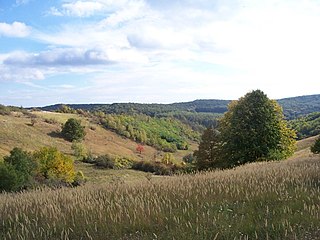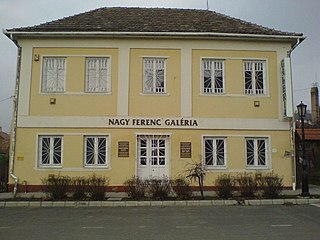
Baranya is a county in southern Hungary. It is part of the Southern Transdanubia statistical region and the historical Baranya region, which was a county (comitatus) in the Kingdom of Hungary dating back to the 11th century. Its current status as one of the 19 counties of Hungary was established in 1950 as part of wider Soviet administrative territorial reform following World War II. It is bordered by Somogy County to the northwest, Tolna County to the north, Bács-Kiskun County and the Danube to the east, and the border with Croatia to the south.

Somogy is an administrative county in present Hungary, and also in the former Kingdom of Hungary.

Tab is a town in Somogy County, Hungary, and the seat of Tab District. It is situated approximately 175 km South West of Budapest and 22 km from Lake Balaton.

Baranya was an administrative county (comitatus) of the Kingdom of Hungary. Its territory is now divided between present-day Baranya County of Hungary and Osijek-Baranja County of Croatia. The capital of the county was Pécs.

Barcs is a border town in Somogy County, Hungary, and the seat of Barcs District. The Drava River marks the southern boundary of the settlement.

Csurgó is a town in Somogy County, Hungary, and the seat of Csurgó District.

Kapoly is a village in Somogy county, Hungary. Political leader János Kádár originates from the village, his childhood was spent in Kapoly.

Pusztaszemes is a village in Somogy County, Hungary. It is known for being the birthplace of János Kádár's father, János Krezinger.

Szabadi is a village in Somogy county, Hungary.

Szenna is a village in Somogy county, Hungary. It is famous for the Szenna Open Air Museum, which won the Europa Nostra award in 1982.

Bálványos is a village in Somogy County, Hungary.

Gadács is a village in Somogy county, Hungary.

Hács is a village in Somogy county, Hungary.

Somogydöröcske is a village in Somogy county, Hungary.

Nágocs is a village in Somogy County, Hungary. Jutom-puszta, Csillag-puszta, Tomé-puszta and Kovászna are all parts of Nágocs.

Kőröshegy is a village directly south of Balatonföldvár in Siófok District, Somogy County, Hungary.

Kötcse is a village in Somogy county, Hungary. The village is known for being a summer resort because of its proximity to Lake Balaton and its good weather conditions. Several houses are weekend houses and have no permanent residents. Among others former Prime Minister and leader of the DK political party, Ferenc Gyurcsány spends his holidays here with his family. Since 2004 the settlement and the Dobozy Chateau hosts the Polgári Piknik meeting organized by the Polgári Magyarországért Alapítvány of the Christian-conservative elite. Leading figures of Hungarian life - politicians, thinkers, scientists, business people - gather together in the village for the event.

Pásztó is a town in Nógrád County, Hungary, beside of the Zagyva river and the Kövicses creek, between the Mátra and Cserhát mountain ranges. As of 2022 census, it has a population of 8664. The town located beside of the Hatvan–Fiľakovo railway line and the main road 21 and 28.9 km from the M3 motorway. The settlement has an own railway station with public transport. Another railway stop is in the north end of the town named Mátraszőlős-Hasznos, and is the common railway stop of Mátraszőlős and the northeast part of the town (Hasznos).

Hercegkút is a village in Borsod-Abaúj-Zemplén County in northeastern Hungary. Swabians— German immigrants — from the Black Forest (Schwarzwald) region of Germany settled here and played a major role in the evolution of the village’s viticulture. The cellars of Gombos Hill and Kőporos are UNESCO World Heritage Sites.

Pócsa is a village and municipality in Baranya county, Hungary. Residents are Magyars, with minority of Germans. Until the end of World War II, the inhabitants' majority was Danube Swabian, also called locally as Stifolder, because their ancestors arrived in the 17th and 18th centuries from Fulda (district). Most of the former German settlers were expelled to Allied-occupied Germany and Allied-occupied Austria in 1945–1948, as a result of the Potsdam Agreement. Only a few Germans of Hungary live there, the majority today are the descendants of Hungarians from the Czechoslovak–Hungarian population exchange. They got the houses of the former Danube Swabian inhabitants.























